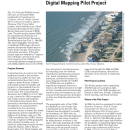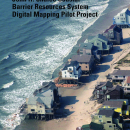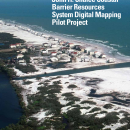States
Delaware, Florida, Louisiana, North Carolina, South CarolinaOverview
The U.S. Fish and Wildlife Service (Service) completed its initial Report to Congress: John H. Chafee Coastal Barrier Resources System John H. Chafee Coastal Barrier Resources System
Learn more about the John H. Chafee Coastal Barrier Resources System, which was established under the Coastal Barrier Resources Act in 1982.
Learn more about John H. Chafee Coastal Barrier Resources System Digital Mapping Pilot Project in 2008, per a directive in Section 6 of the 2000 Coastal Barrier Resources Reauthorization Act (Pub. L. 106-514). The 2008 pilot project report:
- contained draft maps that proposed modifications to 70 units of the Coastal Barrier Resources System (CBRS); and
- described the methodology and results of the pilot project and the feasibility, data standards and needs, and costs of completing digital maps for the remainder of the CBRS. The pilot project units are located in Delaware, Florida, Louisiana, North Carolina, and South Carolina.
The draft pilot project maps underwent public review in 2009. In 2016, the maps were revised to incorporate any appropriate changes based on updated aerial imagery, public input, Coastal Barrier Resources Act criteria, and objective mapping protocols. The Service completed and transmitted its final Report to Congress for the pilot project in 2016 in accordance with Section 3 of the 2006 Coastal Barrier Resources Reauthorization Act (Pub. L. 109-226).
Final Revised Maps
On December 21, 2018, through Pub. L. 115-358, Congress adopted revised maps for 57 of the 65 CBRS units included in the Digital Mapping Pilot Project (pilot project). These units are located in Delaware, Florida, North Carolina, and South Carolina.
On November 25, 2024, through Pub. L. 118-117, Congress adopted revised maps for 6 additional pilot project units: Units LA-01, LA-02, S04, S05, S06, and S07.
Revised maps for the final two pilot project units, NC-06/NC-06P in North Carolina, have not been adopted by Congress.
The adoption of the pilot project maps helps to preserve the long-term integrity of the CBRS by adopting maps prepared by the Service through a comprehensive process to correct legitimate mapping errors and add qualifying areas to the CBRS. This effort also provides more accurate CBRS maps and digital data for planning coastal infrastructure projects, habitat conservation efforts, and flood risk mitigation measures.
Search for the official CBRS maps, which include the final revised maps for pilot project areas.
Access the CBRS mapper to view updated boundaries for pilot project areas.
View digital CBRS data, which includes updated boundary data for pilot project areas.
Search for the official CBRS maps, which include the final revised maps for pilot project areas.
Access the CBRS mapper to view updated boundaries for pilot project areas.
View digital CBRS data, which includes updated boundary data for pilot project areas.






